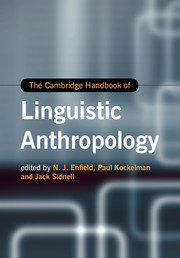Book contents
- The Cambridge Handbook of Linguistic Anthropology
- Series page
- The Cambridge Handbook of Linguistic Anthropology
- Copyright page
- Dedication
- Contents
- Figures
- Tables
- Contributors
- 1 Introduction
- Part I System and function
- Part II Process and formation
- Part III Interaction and intersubjectivity
- Part IV Community and social life
- Part V Interdisciplinary perspectives
- 24 Linguistic anthropology and critical theory
- 25 Linguistic anthropology and sociocultural anthropology
- 26 Sociolinguistics
- 27 Language and archaeology
- 28 Language and biology
- 29 Linguistic anthropology in the age of language automata
- Index
27 - Language and archaeology
State of the art
from Part V - Interdisciplinary perspectives
Published online by Cambridge University Press: 05 October 2014
- The Cambridge Handbook of Linguistic Anthropology
- Series page
- The Cambridge Handbook of Linguistic Anthropology
- Copyright page
- Dedication
- Contents
- Figures
- Tables
- Contributors
- 1 Introduction
- Part I System and function
- Part II Process and formation
- Part III Interaction and intersubjectivity
- Part IV Community and social life
- Part V Interdisciplinary perspectives
- 24 Linguistic anthropology and critical theory
- 25 Linguistic anthropology and sociocultural anthropology
- 26 Sociolinguistics
- 27 Language and archaeology
- 28 Language and biology
- 29 Linguistic anthropology in the age of language automata
- Index
Summary
- Type
- Chapter
- Information
- The Cambridge Handbook of Linguistic Anthropology , pp. 661 - 685Publisher: Cambridge University PressPrint publication year: 2014
- 2
- Cited by

